Leadership and Change Management: Overcoming Barriers and Implementing Effective Strategies
VerifiedAdded on 2023/04/25
|17
|4176
|456
Assignment
AI Summary
In this document we will discuss about Leadership and Change Management and below are the summary points of this document:-
The report aims to recommend a suitable change management process for a chosen company, considering various change management theories.
It identifies barriers to change management within the organization, including operational, financial, physical, and workforce-related aspects.
The report suggests overcoming these barriers through the implementation of Kotter's 8 steps model and highlights the need for strategic improvements in the existing change management model.
Contribute Materials
Your contribution can guide someone’s learning journey. Share your
documents today.

Running head: LEADERSHIP AND CHANGE MANAGEMENT
Leadership and Change Management
Name of the Student
Name of the University
Author name
Leadership and Change Management
Name of the Student
Name of the University
Author name
Secure Best Marks with AI Grader
Need help grading? Try our AI Grader for instant feedback on your assignments.
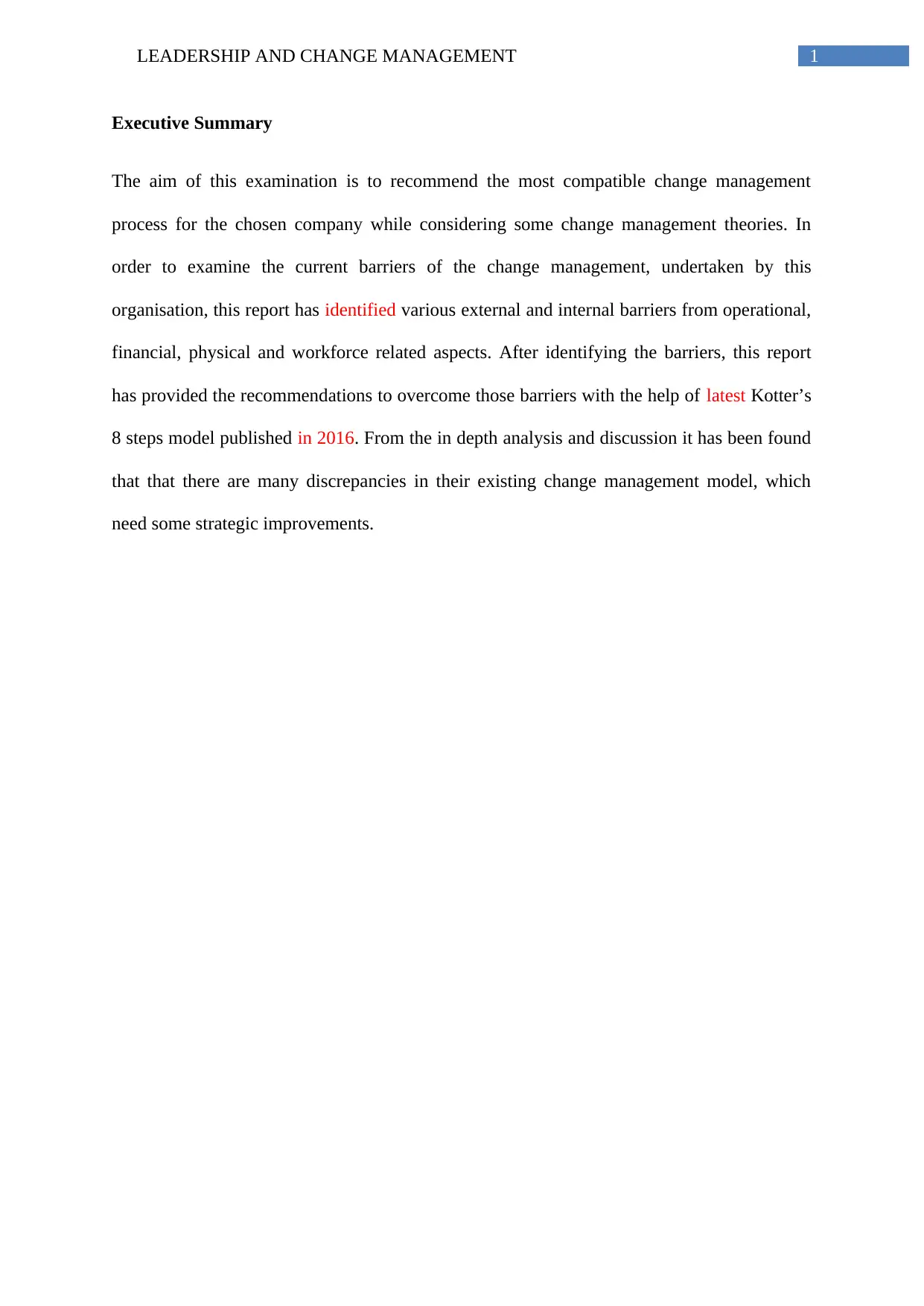
1LEADERSHIP AND CHANGE MANAGEMENT
Executive Summary
The aim of this examination is to recommend the most compatible change management
process for the chosen company while considering some change management theories. In
order to examine the current barriers of the change management, undertaken by this
organisation, this report has identified various external and internal barriers from operational,
financial, physical and workforce related aspects. After identifying the barriers, this report
has provided the recommendations to overcome those barriers with the help of latest Kotter’s
8 steps model published in 2016. From the in depth analysis and discussion it has been found
that that there are many discrepancies in their existing change management model, which
need some strategic improvements.
Executive Summary
The aim of this examination is to recommend the most compatible change management
process for the chosen company while considering some change management theories. In
order to examine the current barriers of the change management, undertaken by this
organisation, this report has identified various external and internal barriers from operational,
financial, physical and workforce related aspects. After identifying the barriers, this report
has provided the recommendations to overcome those barriers with the help of latest Kotter’s
8 steps model published in 2016. From the in depth analysis and discussion it has been found
that that there are many discrepancies in their existing change management model, which
need some strategic improvements.
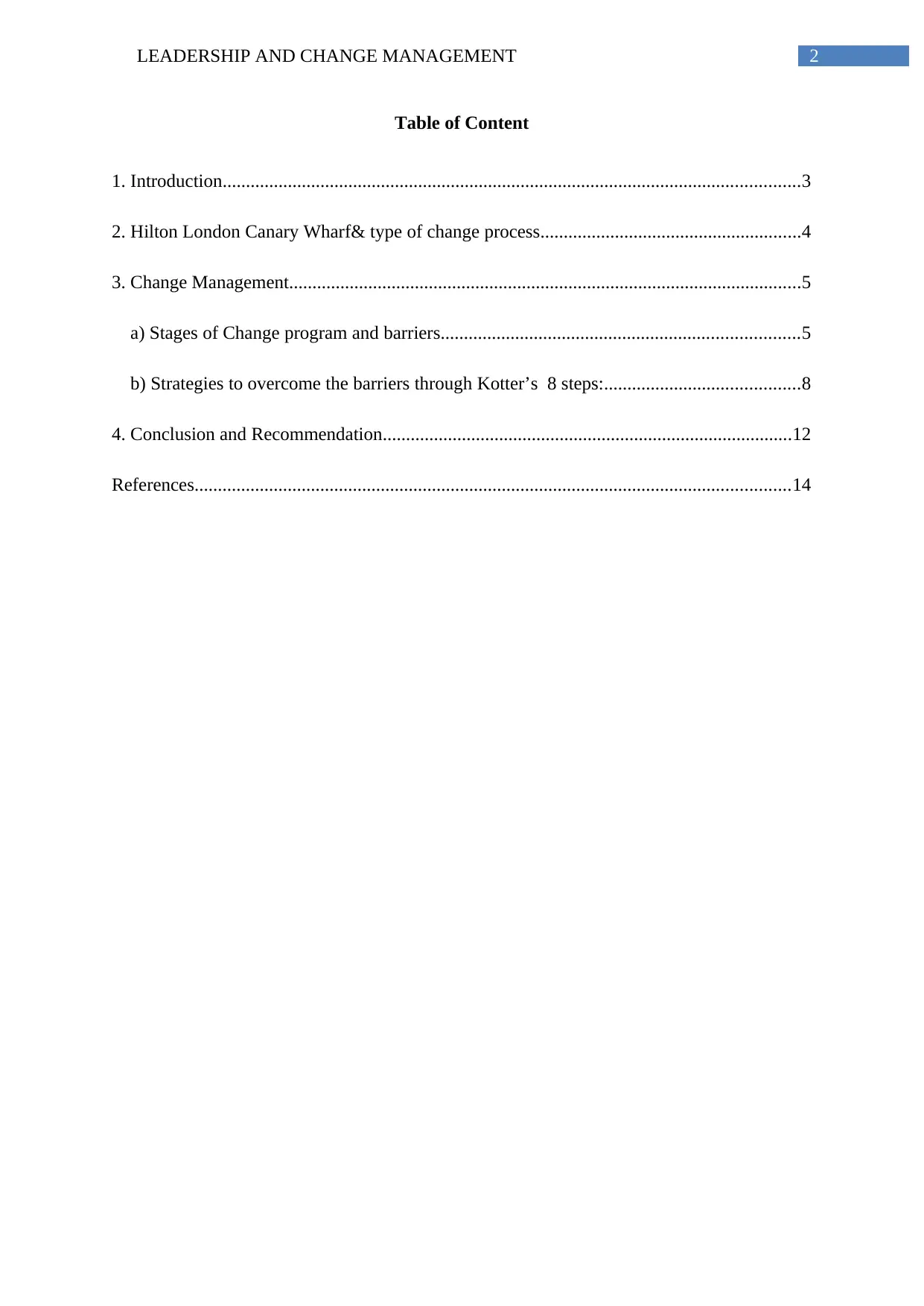
2LEADERSHIP AND CHANGE MANAGEMENT
Table of Content
1. Introduction............................................................................................................................3
2. Hilton London Canary Wharf& type of change process........................................................4
3. Change Management..............................................................................................................5
a) Stages of Change program and barriers.............................................................................5
b) Strategies to overcome the barriers through Kotter’s 8 steps:..........................................8
4. Conclusion and Recommendation........................................................................................12
References................................................................................................................................14
Table of Content
1. Introduction............................................................................................................................3
2. Hilton London Canary Wharf& type of change process........................................................4
3. Change Management..............................................................................................................5
a) Stages of Change program and barriers.............................................................................5
b) Strategies to overcome the barriers through Kotter’s 8 steps:..........................................8
4. Conclusion and Recommendation........................................................................................12
References................................................................................................................................14
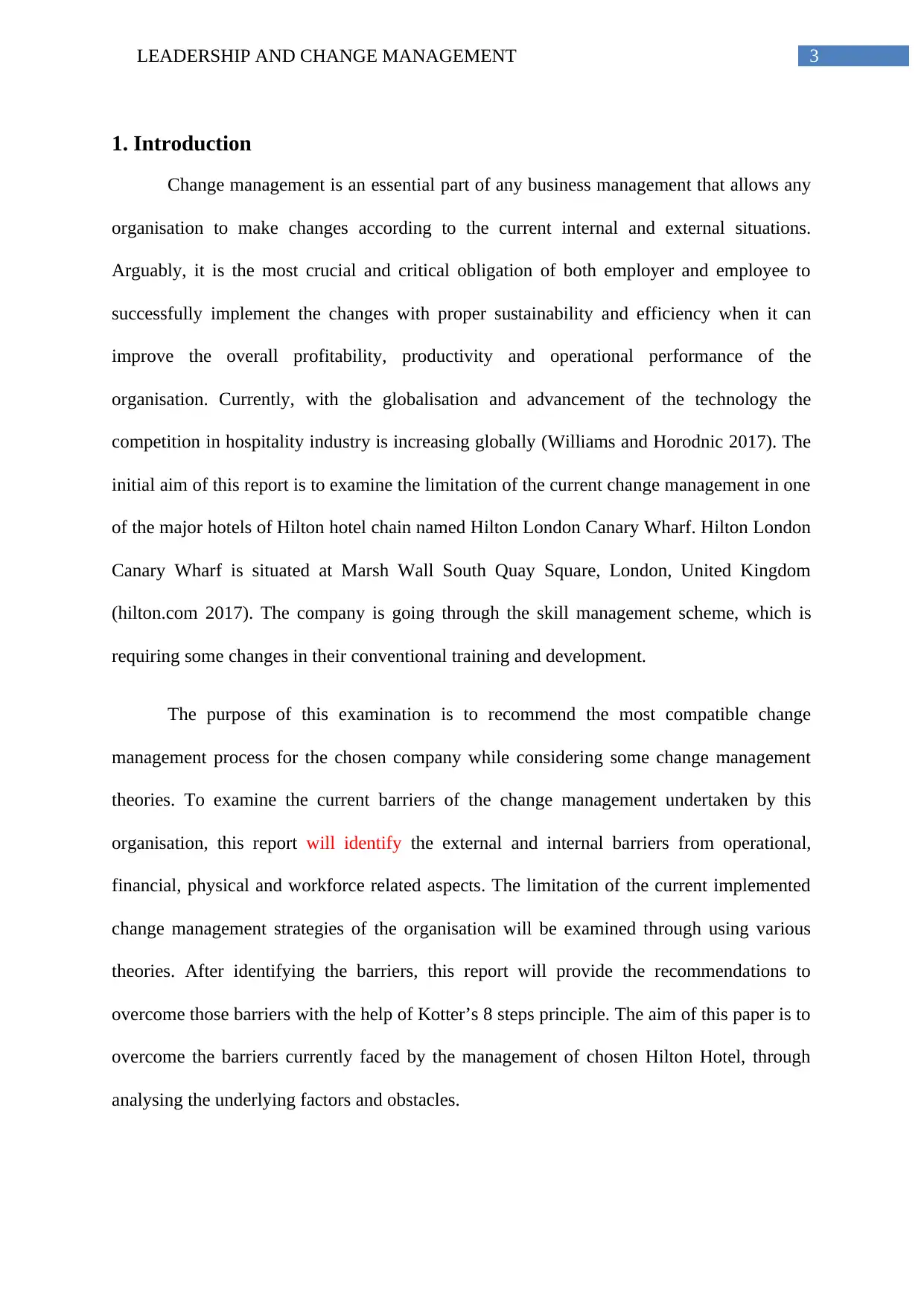
3LEADERSHIP AND CHANGE MANAGEMENT
1. Introduction
Change management is an essential part of any business management that allows any
organisation to make changes according to the current internal and external situations.
Arguably, it is the most crucial and critical obligation of both employer and employee to
successfully implement the changes with proper sustainability and efficiency when it can
improve the overall profitability, productivity and operational performance of the
organisation. Currently, with the globalisation and advancement of the technology the
competition in hospitality industry is increasing globally (Williams and Horodnic 2017). The
initial aim of this report is to examine the limitation of the current change management in one
of the major hotels of Hilton hotel chain named Hilton London Canary Wharf. Hilton London
Canary Wharf is situated at Marsh Wall South Quay Square, London, United Kingdom
(hilton.com 2017). The company is going through the skill management scheme, which is
requiring some changes in their conventional training and development.
The purpose of this examination is to recommend the most compatible change
management process for the chosen company while considering some change management
theories. To examine the current barriers of the change management undertaken by this
organisation, this report will identify the external and internal barriers from operational,
financial, physical and workforce related aspects. The limitation of the current implemented
change management strategies of the organisation will be examined through using various
theories. After identifying the barriers, this report will provide the recommendations to
overcome those barriers with the help of Kotter’s 8 steps principle. The aim of this paper is to
overcome the barriers currently faced by the management of chosen Hilton Hotel, through
analysing the underlying factors and obstacles.
1. Introduction
Change management is an essential part of any business management that allows any
organisation to make changes according to the current internal and external situations.
Arguably, it is the most crucial and critical obligation of both employer and employee to
successfully implement the changes with proper sustainability and efficiency when it can
improve the overall profitability, productivity and operational performance of the
organisation. Currently, with the globalisation and advancement of the technology the
competition in hospitality industry is increasing globally (Williams and Horodnic 2017). The
initial aim of this report is to examine the limitation of the current change management in one
of the major hotels of Hilton hotel chain named Hilton London Canary Wharf. Hilton London
Canary Wharf is situated at Marsh Wall South Quay Square, London, United Kingdom
(hilton.com 2017). The company is going through the skill management scheme, which is
requiring some changes in their conventional training and development.
The purpose of this examination is to recommend the most compatible change
management process for the chosen company while considering some change management
theories. To examine the current barriers of the change management undertaken by this
organisation, this report will identify the external and internal barriers from operational,
financial, physical and workforce related aspects. The limitation of the current implemented
change management strategies of the organisation will be examined through using various
theories. After identifying the barriers, this report will provide the recommendations to
overcome those barriers with the help of Kotter’s 8 steps principle. The aim of this paper is to
overcome the barriers currently faced by the management of chosen Hilton Hotel, through
analysing the underlying factors and obstacles.
Secure Best Marks with AI Grader
Need help grading? Try our AI Grader for instant feedback on your assignments.
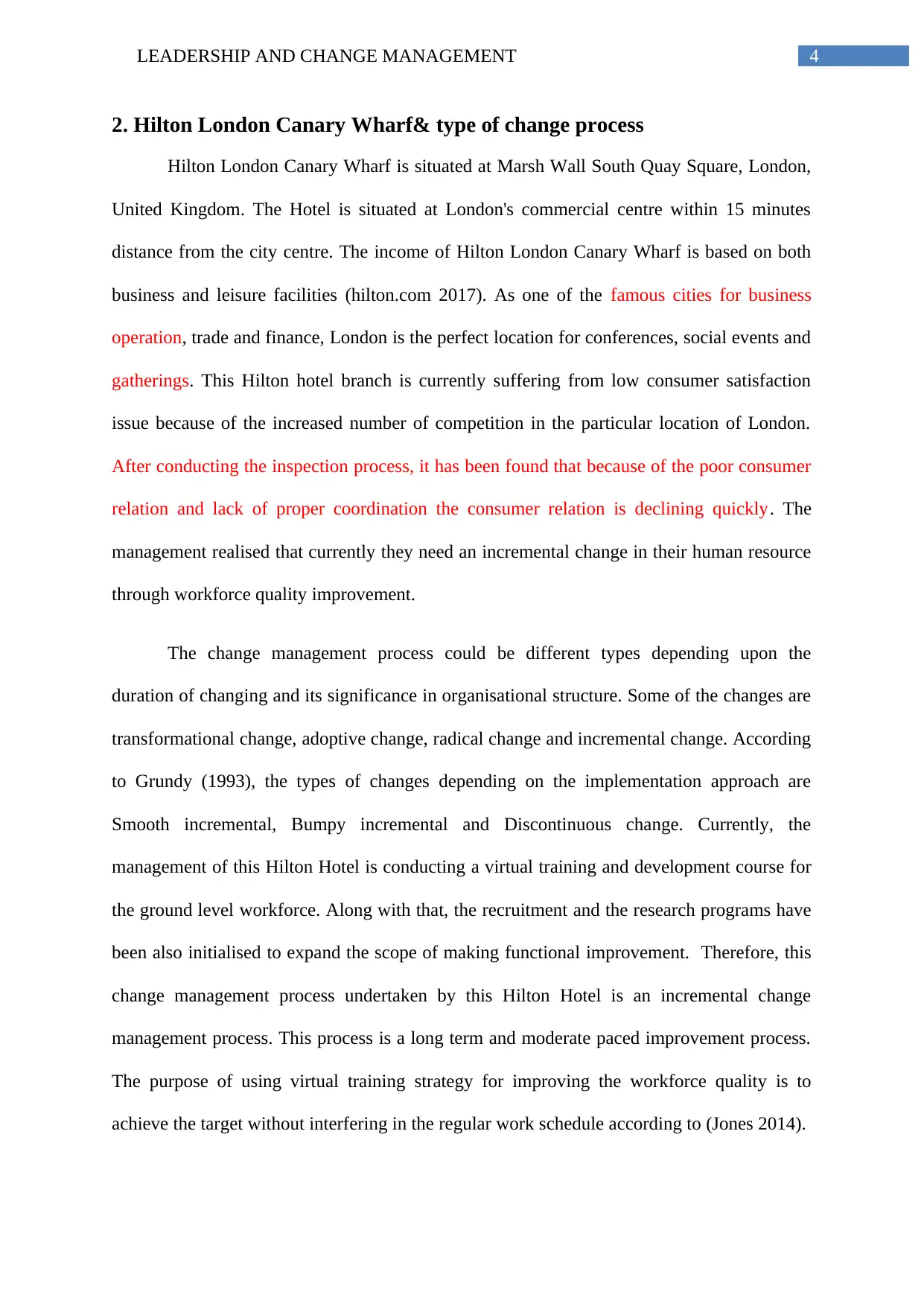
4LEADERSHIP AND CHANGE MANAGEMENT
2. Hilton London Canary Wharf& type of change process
Hilton London Canary Wharf is situated at Marsh Wall South Quay Square, London,
United Kingdom. The Hotel is situated at London's commercial centre within 15 minutes
distance from the city centre. The income of Hilton London Canary Wharf is based on both
business and leisure facilities (hilton.com 2017). As one of the famous cities for business
operation, trade and finance, London is the perfect location for conferences, social events and
gatherings. This Hilton hotel branch is currently suffering from low consumer satisfaction
issue because of the increased number of competition in the particular location of London.
After conducting the inspection process, it has been found that because of the poor consumer
relation and lack of proper coordination the consumer relation is declining quickly. The
management realised that currently they need an incremental change in their human resource
through workforce quality improvement.
The change management process could be different types depending upon the
duration of changing and its significance in organisational structure. Some of the changes are
transformational change, adoptive change, radical change and incremental change. According
to Grundy (1993), the types of changes depending on the implementation approach are
Smooth incremental, Bumpy incremental and Discontinuous change. Currently, the
management of this Hilton Hotel is conducting a virtual training and development course for
the ground level workforce. Along with that, the recruitment and the research programs have
been also initialised to expand the scope of making functional improvement. Therefore, this
change management process undertaken by this Hilton Hotel is an incremental change
management process. This process is a long term and moderate paced improvement process.
The purpose of using virtual training strategy for improving the workforce quality is to
achieve the target without interfering in the regular work schedule according to (Jones 2014).
2. Hilton London Canary Wharf& type of change process
Hilton London Canary Wharf is situated at Marsh Wall South Quay Square, London,
United Kingdom. The Hotel is situated at London's commercial centre within 15 minutes
distance from the city centre. The income of Hilton London Canary Wharf is based on both
business and leisure facilities (hilton.com 2017). As one of the famous cities for business
operation, trade and finance, London is the perfect location for conferences, social events and
gatherings. This Hilton hotel branch is currently suffering from low consumer satisfaction
issue because of the increased number of competition in the particular location of London.
After conducting the inspection process, it has been found that because of the poor consumer
relation and lack of proper coordination the consumer relation is declining quickly. The
management realised that currently they need an incremental change in their human resource
through workforce quality improvement.
The change management process could be different types depending upon the
duration of changing and its significance in organisational structure. Some of the changes are
transformational change, adoptive change, radical change and incremental change. According
to Grundy (1993), the types of changes depending on the implementation approach are
Smooth incremental, Bumpy incremental and Discontinuous change. Currently, the
management of this Hilton Hotel is conducting a virtual training and development course for
the ground level workforce. Along with that, the recruitment and the research programs have
been also initialised to expand the scope of making functional improvement. Therefore, this
change management process undertaken by this Hilton Hotel is an incremental change
management process. This process is a long term and moderate paced improvement process.
The purpose of using virtual training strategy for improving the workforce quality is to
achieve the target without interfering in the regular work schedule according to (Jones 2014).
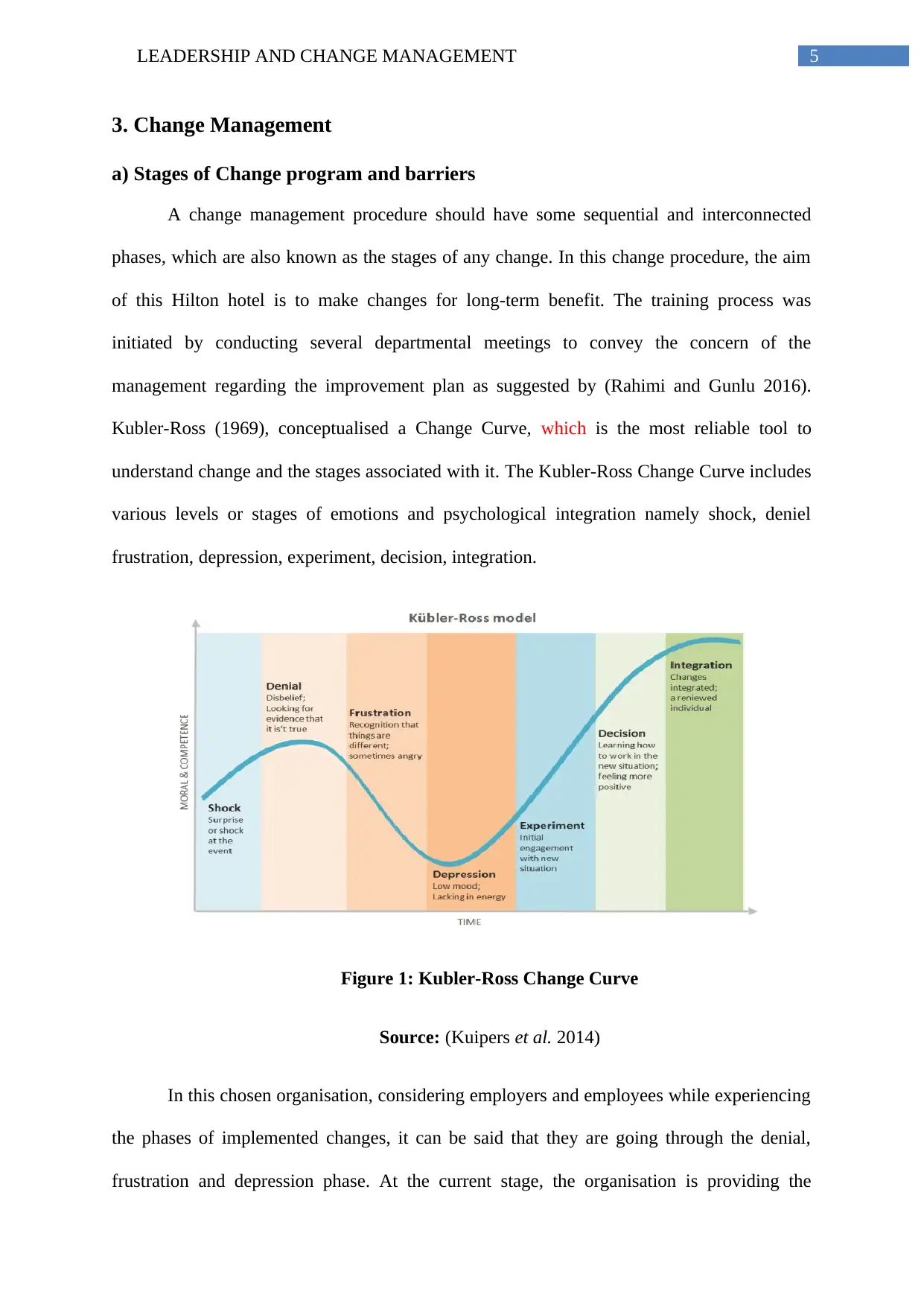
5LEADERSHIP AND CHANGE MANAGEMENT
3. Change Management
a) Stages of Change program and barriers
A change management procedure should have some sequential and interconnected
phases, which are also known as the stages of any change. In this change procedure, the aim
of this Hilton hotel is to make changes for long-term benefit. The training process was
initiated by conducting several departmental meetings to convey the concern of the
management regarding the improvement plan as suggested by (Rahimi and Gunlu 2016).
Kubler-Ross (1969), conceptualised a Change Curve, which is the most reliable tool to
understand change and the stages associated with it. The Kubler-Ross Change Curve includes
various levels or stages of emotions and psychological integration namely shock, deniel
frustration, depression, experiment, decision, integration.
Figure 1: Kubler-Ross Change Curve
Source: (Kuipers et al. 2014)
In this chosen organisation, considering employers and employees while experiencing
the phases of implemented changes, it can be said that they are going through the denial,
frustration and depression phase. At the current stage, the organisation is providing the
3. Change Management
a) Stages of Change program and barriers
A change management procedure should have some sequential and interconnected
phases, which are also known as the stages of any change. In this change procedure, the aim
of this Hilton hotel is to make changes for long-term benefit. The training process was
initiated by conducting several departmental meetings to convey the concern of the
management regarding the improvement plan as suggested by (Rahimi and Gunlu 2016).
Kubler-Ross (1969), conceptualised a Change Curve, which is the most reliable tool to
understand change and the stages associated with it. The Kubler-Ross Change Curve includes
various levels or stages of emotions and psychological integration namely shock, deniel
frustration, depression, experiment, decision, integration.
Figure 1: Kubler-Ross Change Curve
Source: (Kuipers et al. 2014)
In this chosen organisation, considering employers and employees while experiencing
the phases of implemented changes, it can be said that they are going through the denial,
frustration and depression phase. At the current stage, the organisation is providing the
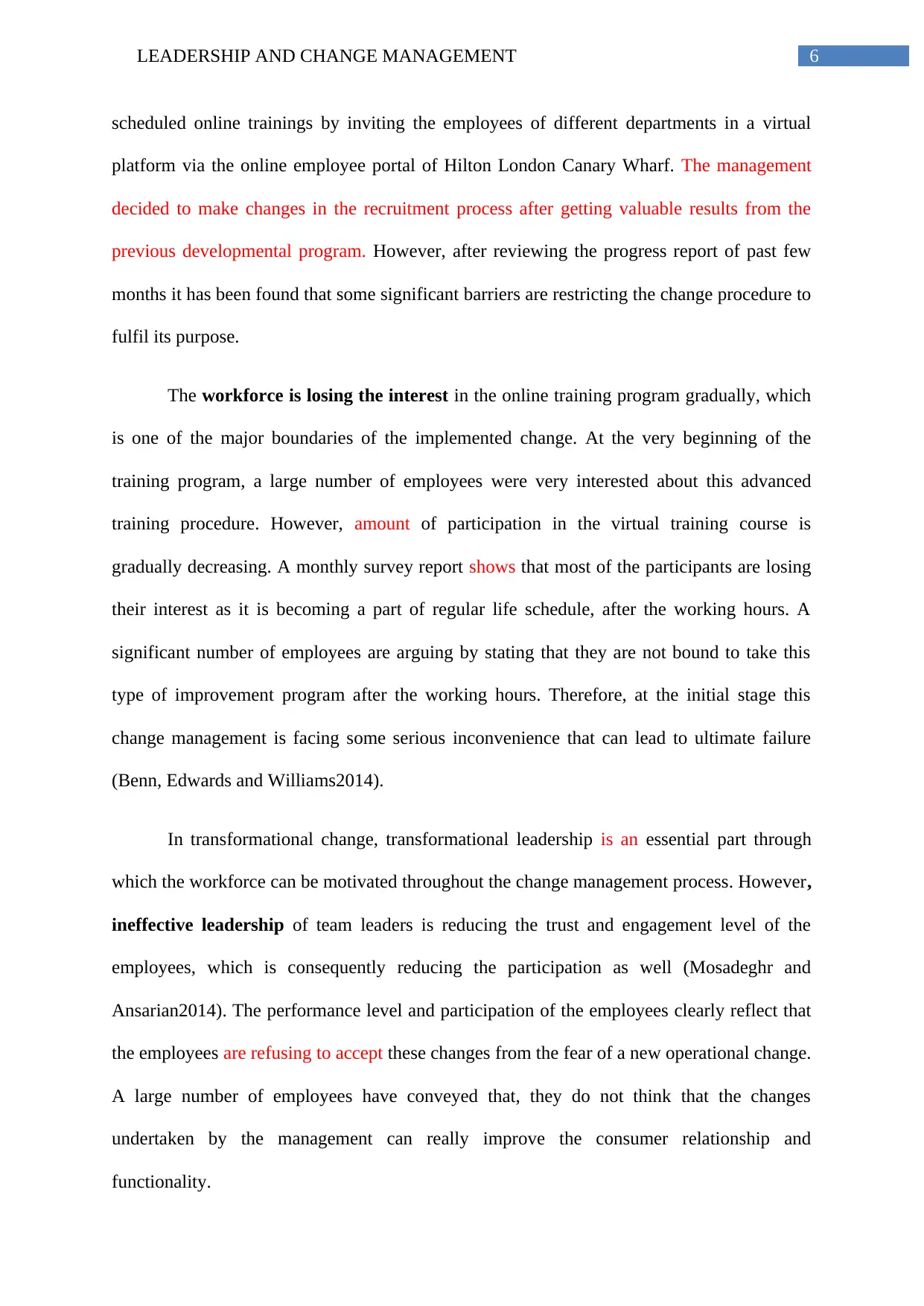
6LEADERSHIP AND CHANGE MANAGEMENT
scheduled online trainings by inviting the employees of different departments in a virtual
platform via the online employee portal of Hilton London Canary Wharf. The management
decided to make changes in the recruitment process after getting valuable results from the
previous developmental program. However, after reviewing the progress report of past few
months it has been found that some significant barriers are restricting the change procedure to
fulfil its purpose.
The workforce is losing the interest in the online training program gradually, which
is one of the major boundaries of the implemented change. At the very beginning of the
training program, a large number of employees were very interested about this advanced
training procedure. However, amount of participation in the virtual training course is
gradually decreasing. A monthly survey report shows that most of the participants are losing
their interest as it is becoming a part of regular life schedule, after the working hours. A
significant number of employees are arguing by stating that they are not bound to take this
type of improvement program after the working hours. Therefore, at the initial stage this
change management is facing some serious inconvenience that can lead to ultimate failure
(Benn, Edwards and Williams2014).
In transformational change, transformational leadership is an essential part through
which the workforce can be motivated throughout the change management process. However,
ineffective leadership of team leaders is reducing the trust and engagement level of the
employees, which is consequently reducing the participation as well (Mosadeghr and
Ansarian2014). The performance level and participation of the employees clearly reflect that
the employees are refusing to accept these changes from the fear of a new operational change.
A large number of employees have conveyed that, they do not think that the changes
undertaken by the management can really improve the consumer relationship and
functionality.
scheduled online trainings by inviting the employees of different departments in a virtual
platform via the online employee portal of Hilton London Canary Wharf. The management
decided to make changes in the recruitment process after getting valuable results from the
previous developmental program. However, after reviewing the progress report of past few
months it has been found that some significant barriers are restricting the change procedure to
fulfil its purpose.
The workforce is losing the interest in the online training program gradually, which
is one of the major boundaries of the implemented change. At the very beginning of the
training program, a large number of employees were very interested about this advanced
training procedure. However, amount of participation in the virtual training course is
gradually decreasing. A monthly survey report shows that most of the participants are losing
their interest as it is becoming a part of regular life schedule, after the working hours. A
significant number of employees are arguing by stating that they are not bound to take this
type of improvement program after the working hours. Therefore, at the initial stage this
change management is facing some serious inconvenience that can lead to ultimate failure
(Benn, Edwards and Williams2014).
In transformational change, transformational leadership is an essential part through
which the workforce can be motivated throughout the change management process. However,
ineffective leadership of team leaders is reducing the trust and engagement level of the
employees, which is consequently reducing the participation as well (Mosadeghr and
Ansarian2014). The performance level and participation of the employees clearly reflect that
the employees are refusing to accept these changes from the fear of a new operational change.
A large number of employees have conveyed that, they do not think that the changes
undertaken by the management can really improve the consumer relationship and
functionality.
Paraphrase This Document
Need a fresh take? Get an instant paraphrase of this document with our AI Paraphraser
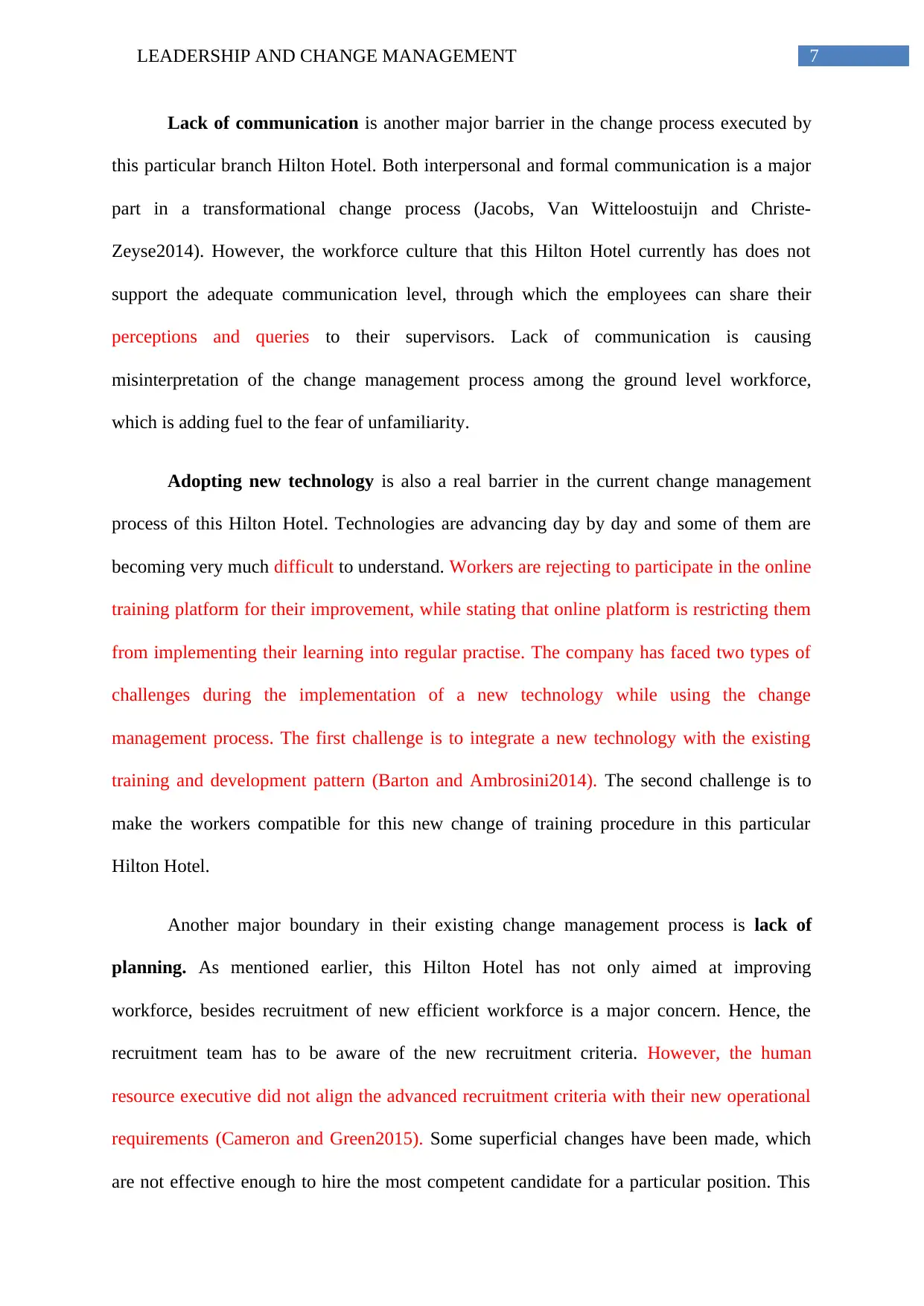
7LEADERSHIP AND CHANGE MANAGEMENT
Lack of communication is another major barrier in the change process executed by
this particular branch Hilton Hotel. Both interpersonal and formal communication is a major
part in a transformational change process (Jacobs, Van Witteloostuijn and Christe-
Zeyse2014). However, the workforce culture that this Hilton Hotel currently has does not
support the adequate communication level, through which the employees can share their
perceptions and queries to their supervisors. Lack of communication is causing
misinterpretation of the change management process among the ground level workforce,
which is adding fuel to the fear of unfamiliarity.
Adopting new technology is also a real barrier in the current change management
process of this Hilton Hotel. Technologies are advancing day by day and some of them are
becoming very much difficult to understand. Workers are rejecting to participate in the online
training platform for their improvement, while stating that online platform is restricting them
from implementing their learning into regular practise. The company has faced two types of
challenges during the implementation of a new technology while using the change
management process. The first challenge is to integrate a new technology with the existing
training and development pattern (Barton and Ambrosini2014). The second challenge is to
make the workers compatible for this new change of training procedure in this particular
Hilton Hotel.
Another major boundary in their existing change management process is lack of
planning. As mentioned earlier, this Hilton Hotel has not only aimed at improving
workforce, besides recruitment of new efficient workforce is a major concern. Hence, the
recruitment team has to be aware of the new recruitment criteria. However, the human
resource executive did not align the advanced recruitment criteria with their new operational
requirements (Cameron and Green2015). Some superficial changes have been made, which
are not effective enough to hire the most competent candidate for a particular position. This
Lack of communication is another major barrier in the change process executed by
this particular branch Hilton Hotel. Both interpersonal and formal communication is a major
part in a transformational change process (Jacobs, Van Witteloostuijn and Christe-
Zeyse2014). However, the workforce culture that this Hilton Hotel currently has does not
support the adequate communication level, through which the employees can share their
perceptions and queries to their supervisors. Lack of communication is causing
misinterpretation of the change management process among the ground level workforce,
which is adding fuel to the fear of unfamiliarity.
Adopting new technology is also a real barrier in the current change management
process of this Hilton Hotel. Technologies are advancing day by day and some of them are
becoming very much difficult to understand. Workers are rejecting to participate in the online
training platform for their improvement, while stating that online platform is restricting them
from implementing their learning into regular practise. The company has faced two types of
challenges during the implementation of a new technology while using the change
management process. The first challenge is to integrate a new technology with the existing
training and development pattern (Barton and Ambrosini2014). The second challenge is to
make the workers compatible for this new change of training procedure in this particular
Hilton Hotel.
Another major boundary in their existing change management process is lack of
planning. As mentioned earlier, this Hilton Hotel has not only aimed at improving
workforce, besides recruitment of new efficient workforce is a major concern. Hence, the
recruitment team has to be aware of the new recruitment criteria. However, the human
resource executive did not align the advanced recruitment criteria with their new operational
requirements (Cameron and Green2015). Some superficial changes have been made, which
are not effective enough to hire the most competent candidate for a particular position. This

8LEADERSHIP AND CHANGE MANAGEMENT
workforce recruitment related anomaly restricting their current change management process
to achieve the desired success rate.
b) Strategies to overcome the barriers through Kotter’s 8 steps:
Before developing the change management strategic planning to overcome the above
mentioned barriers through Kotter’s 8 steps acceleration theory, the brief discussion of this
theory is essential. The 8 steps accelerate change management model proposed by Kotter in
2014 has 8 stages namely Creating a Sense of Urgency, Building Powerful Guiding
Coalitions, Developing a Strategic Vision and Initiatives, Enlisting a Volunteer Army,
Enabling Action by Removing Obstacles, Creating Short-term Wins, Sustaining Acceleration
and Instituting Change, (Al-Haddad and Kotnour2015).
Figure 2: Kotters 8 step to Accelerate Change
Source: (Small et al. 2016)
Creating a
Sense of
Urgency
Building
Powerful
Guiding
Coalitions
Developing a
Strategic Vision
and Initiatives
Enlisting a
Volunteer
Army
Enabling
Action by
Removing
Obstacles
Creating
Short-term
Wins
Sustain
Acceleration
Instituting
Change
workforce recruitment related anomaly restricting their current change management process
to achieve the desired success rate.
b) Strategies to overcome the barriers through Kotter’s 8 steps:
Before developing the change management strategic planning to overcome the above
mentioned barriers through Kotter’s 8 steps acceleration theory, the brief discussion of this
theory is essential. The 8 steps accelerate change management model proposed by Kotter in
2014 has 8 stages namely Creating a Sense of Urgency, Building Powerful Guiding
Coalitions, Developing a Strategic Vision and Initiatives, Enlisting a Volunteer Army,
Enabling Action by Removing Obstacles, Creating Short-term Wins, Sustaining Acceleration
and Instituting Change, (Al-Haddad and Kotnour2015).
Figure 2: Kotters 8 step to Accelerate Change
Source: (Small et al. 2016)
Creating a
Sense of
Urgency
Building
Powerful
Guiding
Coalitions
Developing a
Strategic Vision
and Initiatives
Enlisting a
Volunteer
Army
Enabling
Action by
Removing
Obstacles
Creating
Short-term
Wins
Sustain
Acceleration
Instituting
Change
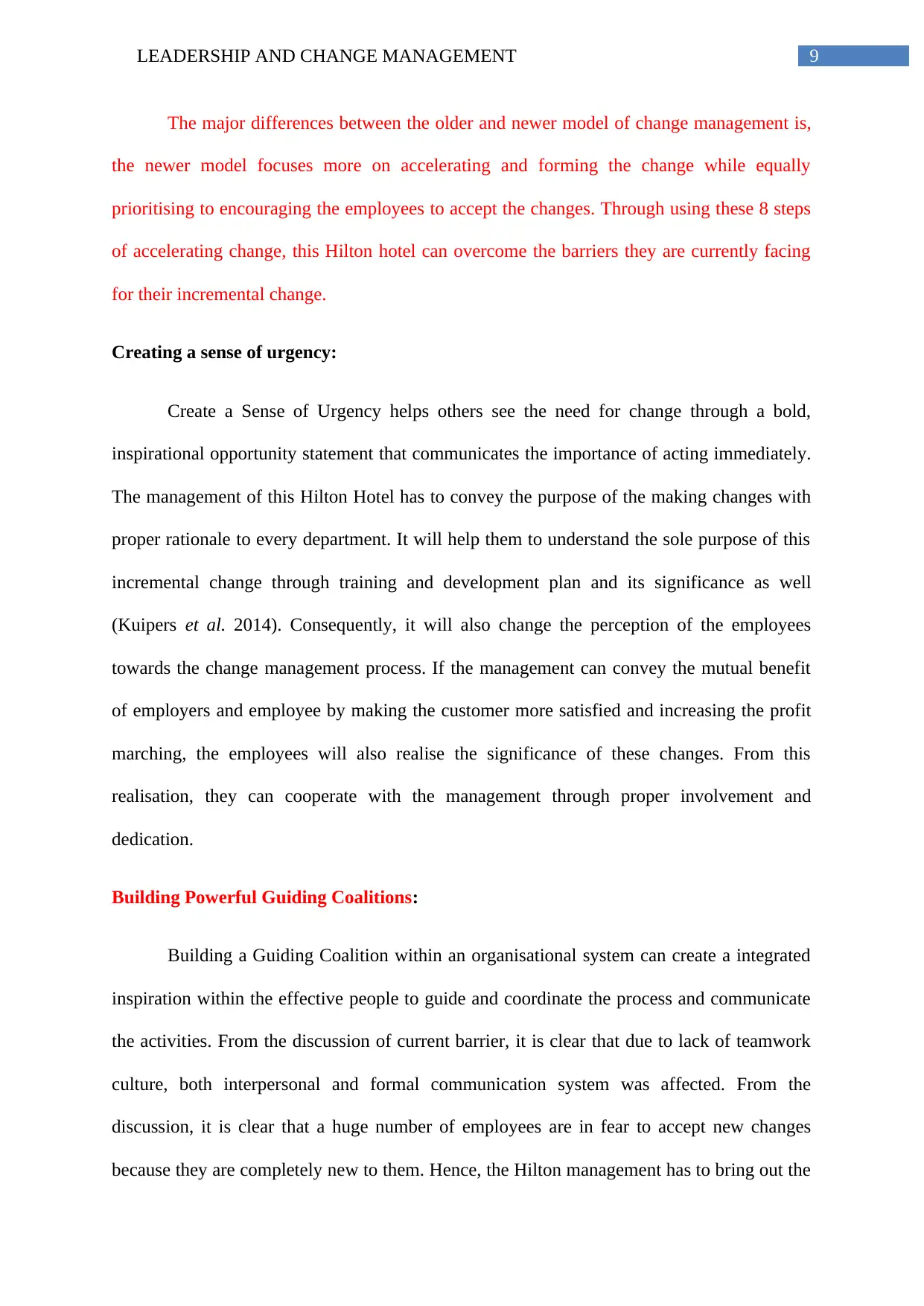
9LEADERSHIP AND CHANGE MANAGEMENT
The major differences between the older and newer model of change management is,
the newer model focuses more on accelerating and forming the change while equally
prioritising to encouraging the employees to accept the changes. Through using these 8 steps
of accelerating change, this Hilton hotel can overcome the barriers they are currently facing
for their incremental change.
Creating a sense of urgency:
Create a Sense of Urgency helps others see the need for change through a bold,
inspirational opportunity statement that communicates the importance of acting immediately.
The management of this Hilton Hotel has to convey the purpose of the making changes with
proper rationale to every department. It will help them to understand the sole purpose of this
incremental change through training and development plan and its significance as well
(Kuipers et al. 2014). Consequently, it will also change the perception of the employees
towards the change management process. If the management can convey the mutual benefit
of employers and employee by making the customer more satisfied and increasing the profit
marching, the employees will also realise the significance of these changes. From this
realisation, they can cooperate with the management through proper involvement and
dedication.
Building Powerful Guiding Coalitions:
Building a Guiding Coalition within an organisational system can create a integrated
inspiration within the effective people to guide and coordinate the process and communicate
the activities. From the discussion of current barrier, it is clear that due to lack of teamwork
culture, both interpersonal and formal communication system was affected. From the
discussion, it is clear that a huge number of employees are in fear to accept new changes
because they are completely new to them. Hence, the Hilton management has to bring out the
The major differences between the older and newer model of change management is,
the newer model focuses more on accelerating and forming the change while equally
prioritising to encouraging the employees to accept the changes. Through using these 8 steps
of accelerating change, this Hilton hotel can overcome the barriers they are currently facing
for their incremental change.
Creating a sense of urgency:
Create a Sense of Urgency helps others see the need for change through a bold,
inspirational opportunity statement that communicates the importance of acting immediately.
The management of this Hilton Hotel has to convey the purpose of the making changes with
proper rationale to every department. It will help them to understand the sole purpose of this
incremental change through training and development plan and its significance as well
(Kuipers et al. 2014). Consequently, it will also change the perception of the employees
towards the change management process. If the management can convey the mutual benefit
of employers and employee by making the customer more satisfied and increasing the profit
marching, the employees will also realise the significance of these changes. From this
realisation, they can cooperate with the management through proper involvement and
dedication.
Building Powerful Guiding Coalitions:
Building a Guiding Coalition within an organisational system can create a integrated
inspiration within the effective people to guide and coordinate the process and communicate
the activities. From the discussion of current barrier, it is clear that due to lack of teamwork
culture, both interpersonal and formal communication system was affected. From the
discussion, it is clear that a huge number of employees are in fear to accept new changes
because they are completely new to them. Hence, the Hilton management has to bring out the
Secure Best Marks with AI Grader
Need help grading? Try our AI Grader for instant feedback on your assignments.

10LEADERSHIP AND CHANGE MANAGEMENT
whole concept of changing the operational system, especially in consumer relation, sales and
marketing operation. Both interpersonal and formal communication techniques can be used to
describe the step by step procedures for changes to the employees (Shirey2013).
Developing a Strategic Vision and Initiatives:
The Strategic Vision and Initiatives implies clarify how the future will be different
from the past and how an organisation can make that future a reality through initiatives linked
directly to the vision. In this Hilton Hotel, The strategic vision is to make the workforce
comprehensive and efficient enough to improve the consumer relation significantly. In other
words, the strategic vision of this Hilton Hotel is to improve the consumer handling quality
through workforce improvement within next 6 month. The strategy is to make the training
program more interesting and valuable to all employees. It has been found virtual platform
based training program is not effectively engaging the employees. Therefore, to strategically
handle this situation while keeping their strategy vision unchanged they have to operate their
training course in office premises. Strategically, it will allow more employees to be involved
while considering this training program as viable and significant part of quality improvement
(Al-Haddad and Kotnour2015). With proper training materials and strategic planing, the
training and development process will consume very limited time within the regular working
hours. The training will be more effective if the subject will be transferred to the audience
more prominently rather than making a long time boring discussion. Therefore, the strategy
of the management should be passing the new information to trainee employees in a way that
is more effective.
Enlisting a Volunteer Army:
Therefore, the management of this Hilton Hotel has to develop a team who can act as
a group of informal mediator among the effective personnel. Besides, developing a teamwork
whole concept of changing the operational system, especially in consumer relation, sales and
marketing operation. Both interpersonal and formal communication techniques can be used to
describe the step by step procedures for changes to the employees (Shirey2013).
Developing a Strategic Vision and Initiatives:
The Strategic Vision and Initiatives implies clarify how the future will be different
from the past and how an organisation can make that future a reality through initiatives linked
directly to the vision. In this Hilton Hotel, The strategic vision is to make the workforce
comprehensive and efficient enough to improve the consumer relation significantly. In other
words, the strategic vision of this Hilton Hotel is to improve the consumer handling quality
through workforce improvement within next 6 month. The strategy is to make the training
program more interesting and valuable to all employees. It has been found virtual platform
based training program is not effectively engaging the employees. Therefore, to strategically
handle this situation while keeping their strategy vision unchanged they have to operate their
training course in office premises. Strategically, it will allow more employees to be involved
while considering this training program as viable and significant part of quality improvement
(Al-Haddad and Kotnour2015). With proper training materials and strategic planing, the
training and development process will consume very limited time within the regular working
hours. The training will be more effective if the subject will be transferred to the audience
more prominently rather than making a long time boring discussion. Therefore, the strategy
of the management should be passing the new information to trainee employees in a way that
is more effective.
Enlisting a Volunteer Army:
Therefore, the management of this Hilton Hotel has to develop a team who can act as
a group of informal mediator among the effective personnel. Besides, developing a teamwork
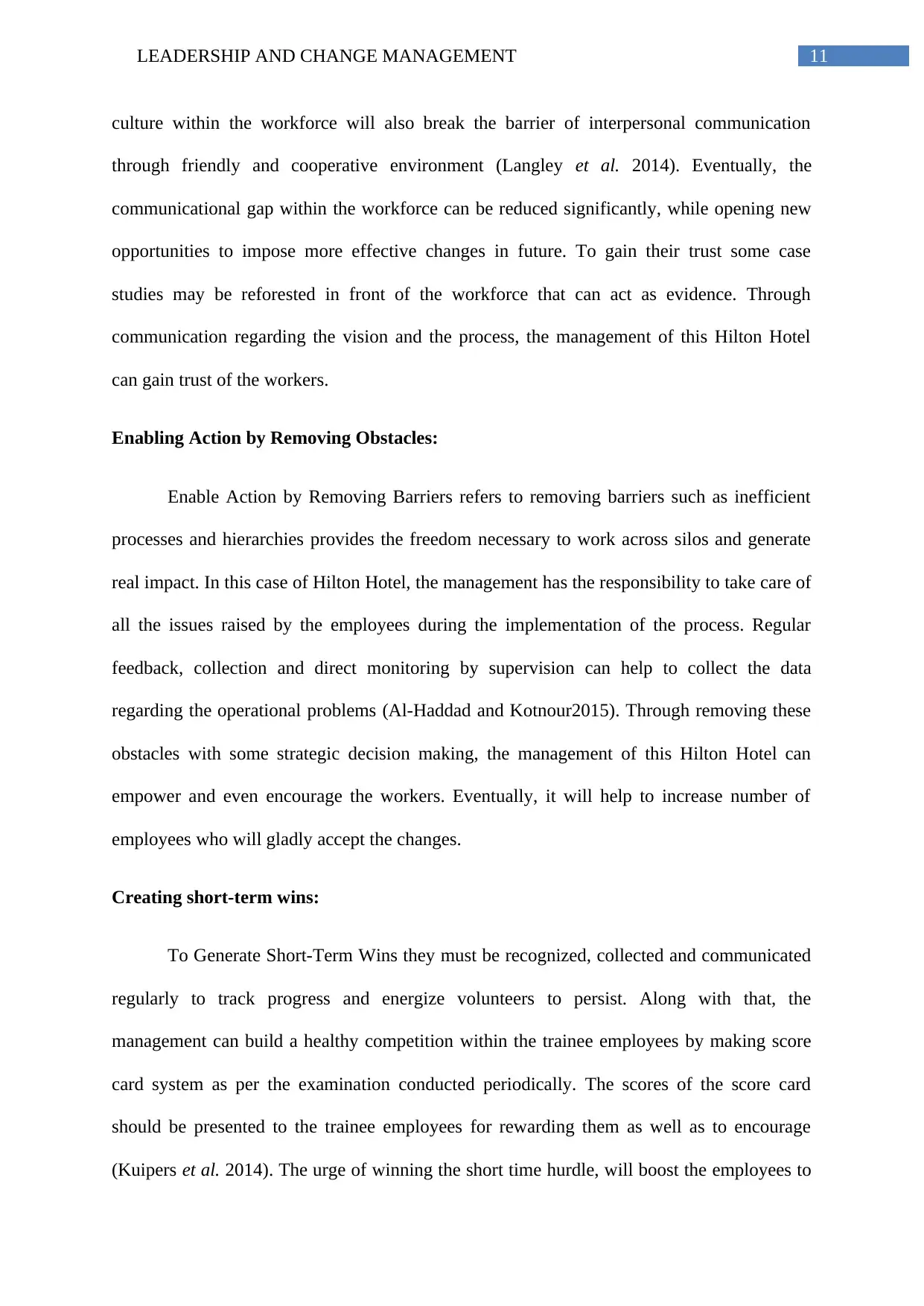
11LEADERSHIP AND CHANGE MANAGEMENT
culture within the workforce will also break the barrier of interpersonal communication
through friendly and cooperative environment (Langley et al. 2014). Eventually, the
communicational gap within the workforce can be reduced significantly, while opening new
opportunities to impose more effective changes in future. To gain their trust some case
studies may be reforested in front of the workforce that can act as evidence. Through
communication regarding the vision and the process, the management of this Hilton Hotel
can gain trust of the workers.
Enabling Action by Removing Obstacles:
Enable Action by Removing Barriers refers to removing barriers such as inefficient
processes and hierarchies provides the freedom necessary to work across silos and generate
real impact. In this case of Hilton Hotel, the management has the responsibility to take care of
all the issues raised by the employees during the implementation of the process. Regular
feedback, collection and direct monitoring by supervision can help to collect the data
regarding the operational problems (Al-Haddad and Kotnour2015). Through removing these
obstacles with some strategic decision making, the management of this Hilton Hotel can
empower and even encourage the workers. Eventually, it will help to increase number of
employees who will gladly accept the changes.
Creating short-term wins:
To Generate Short-Term Wins they must be recognized, collected and communicated
regularly to track progress and energize volunteers to persist. Along with that, the
management can build a healthy competition within the trainee employees by making score
card system as per the examination conducted periodically. The scores of the score card
should be presented to the trainee employees for rewarding them as well as to encourage
(Kuipers et al. 2014). The urge of winning the short time hurdle, will boost the employees to
culture within the workforce will also break the barrier of interpersonal communication
through friendly and cooperative environment (Langley et al. 2014). Eventually, the
communicational gap within the workforce can be reduced significantly, while opening new
opportunities to impose more effective changes in future. To gain their trust some case
studies may be reforested in front of the workforce that can act as evidence. Through
communication regarding the vision and the process, the management of this Hilton Hotel
can gain trust of the workers.
Enabling Action by Removing Obstacles:
Enable Action by Removing Barriers refers to removing barriers such as inefficient
processes and hierarchies provides the freedom necessary to work across silos and generate
real impact. In this case of Hilton Hotel, the management has the responsibility to take care of
all the issues raised by the employees during the implementation of the process. Regular
feedback, collection and direct monitoring by supervision can help to collect the data
regarding the operational problems (Al-Haddad and Kotnour2015). Through removing these
obstacles with some strategic decision making, the management of this Hilton Hotel can
empower and even encourage the workers. Eventually, it will help to increase number of
employees who will gladly accept the changes.
Creating short-term wins:
To Generate Short-Term Wins they must be recognized, collected and communicated
regularly to track progress and energize volunteers to persist. Along with that, the
management can build a healthy competition within the trainee employees by making score
card system as per the examination conducted periodically. The scores of the score card
should be presented to the trainee employees for rewarding them as well as to encourage
(Kuipers et al. 2014). The urge of winning the short time hurdle, will boost the employees to
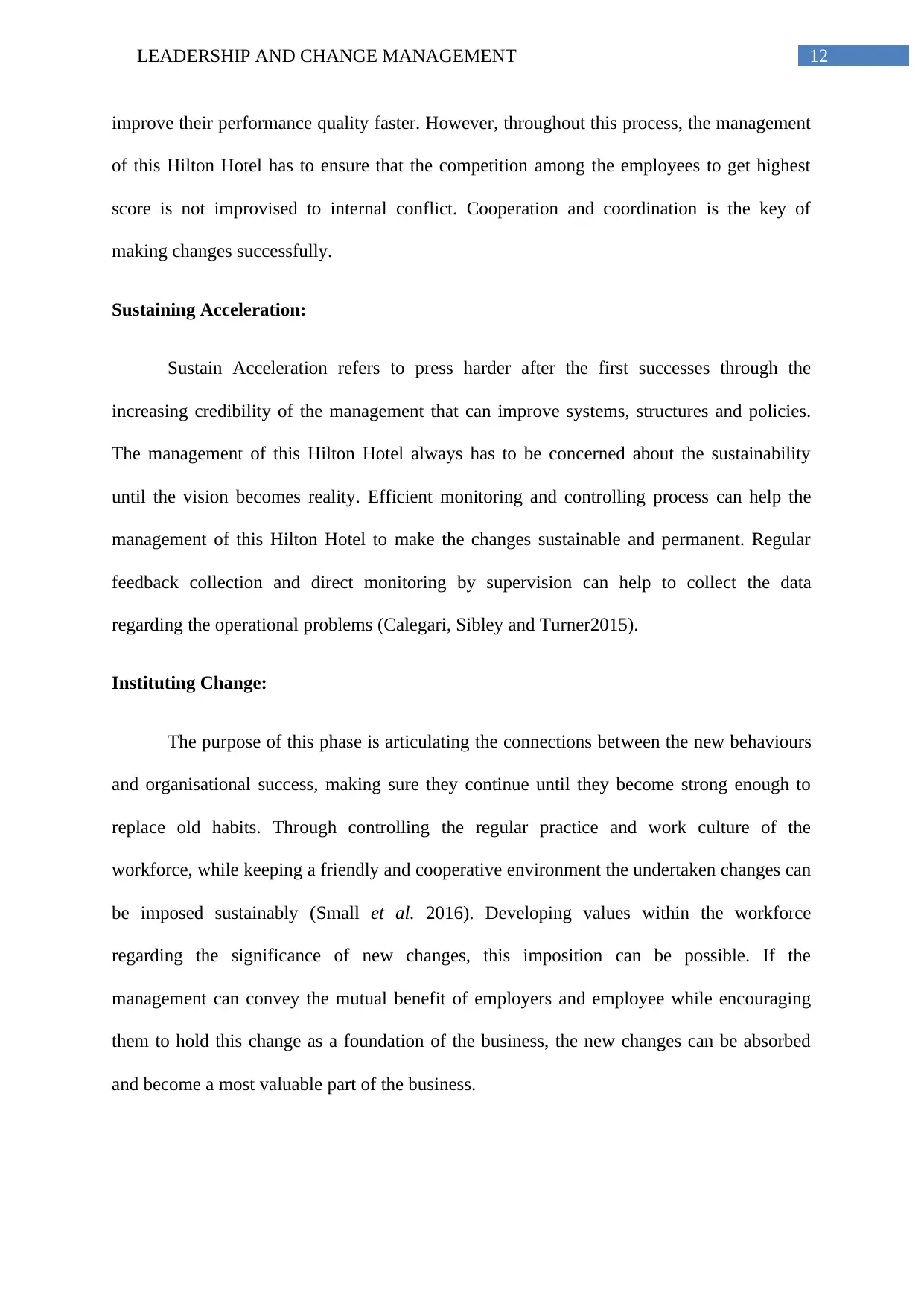
12LEADERSHIP AND CHANGE MANAGEMENT
improve their performance quality faster. However, throughout this process, the management
of this Hilton Hotel has to ensure that the competition among the employees to get highest
score is not improvised to internal conflict. Cooperation and coordination is the key of
making changes successfully.
Sustaining Acceleration:
Sustain Acceleration refers to press harder after the first successes through the
increasing credibility of the management that can improve systems, structures and policies.
The management of this Hilton Hotel always has to be concerned about the sustainability
until the vision becomes reality. Efficient monitoring and controlling process can help the
management of this Hilton Hotel to make the changes sustainable and permanent. Regular
feedback collection and direct monitoring by supervision can help to collect the data
regarding the operational problems (Calegari, Sibley and Turner2015).
Instituting Change:
The purpose of this phase is articulating the connections between the new behaviours
and organisational success, making sure they continue until they become strong enough to
replace old habits. Through controlling the regular practice and work culture of the
workforce, while keeping a friendly and cooperative environment the undertaken changes can
be imposed sustainably (Small et al. 2016). Developing values within the workforce
regarding the significance of new changes, this imposition can be possible. If the
management can convey the mutual benefit of employers and employee while encouraging
them to hold this change as a foundation of the business, the new changes can be absorbed
and become a most valuable part of the business.
improve their performance quality faster. However, throughout this process, the management
of this Hilton Hotel has to ensure that the competition among the employees to get highest
score is not improvised to internal conflict. Cooperation and coordination is the key of
making changes successfully.
Sustaining Acceleration:
Sustain Acceleration refers to press harder after the first successes through the
increasing credibility of the management that can improve systems, structures and policies.
The management of this Hilton Hotel always has to be concerned about the sustainability
until the vision becomes reality. Efficient monitoring and controlling process can help the
management of this Hilton Hotel to make the changes sustainable and permanent. Regular
feedback collection and direct monitoring by supervision can help to collect the data
regarding the operational problems (Calegari, Sibley and Turner2015).
Instituting Change:
The purpose of this phase is articulating the connections between the new behaviours
and organisational success, making sure they continue until they become strong enough to
replace old habits. Through controlling the regular practice and work culture of the
workforce, while keeping a friendly and cooperative environment the undertaken changes can
be imposed sustainably (Small et al. 2016). Developing values within the workforce
regarding the significance of new changes, this imposition can be possible. If the
management can convey the mutual benefit of employers and employee while encouraging
them to hold this change as a foundation of the business, the new changes can be absorbed
and become a most valuable part of the business.
Paraphrase This Document
Need a fresh take? Get an instant paraphrase of this document with our AI Paraphraser
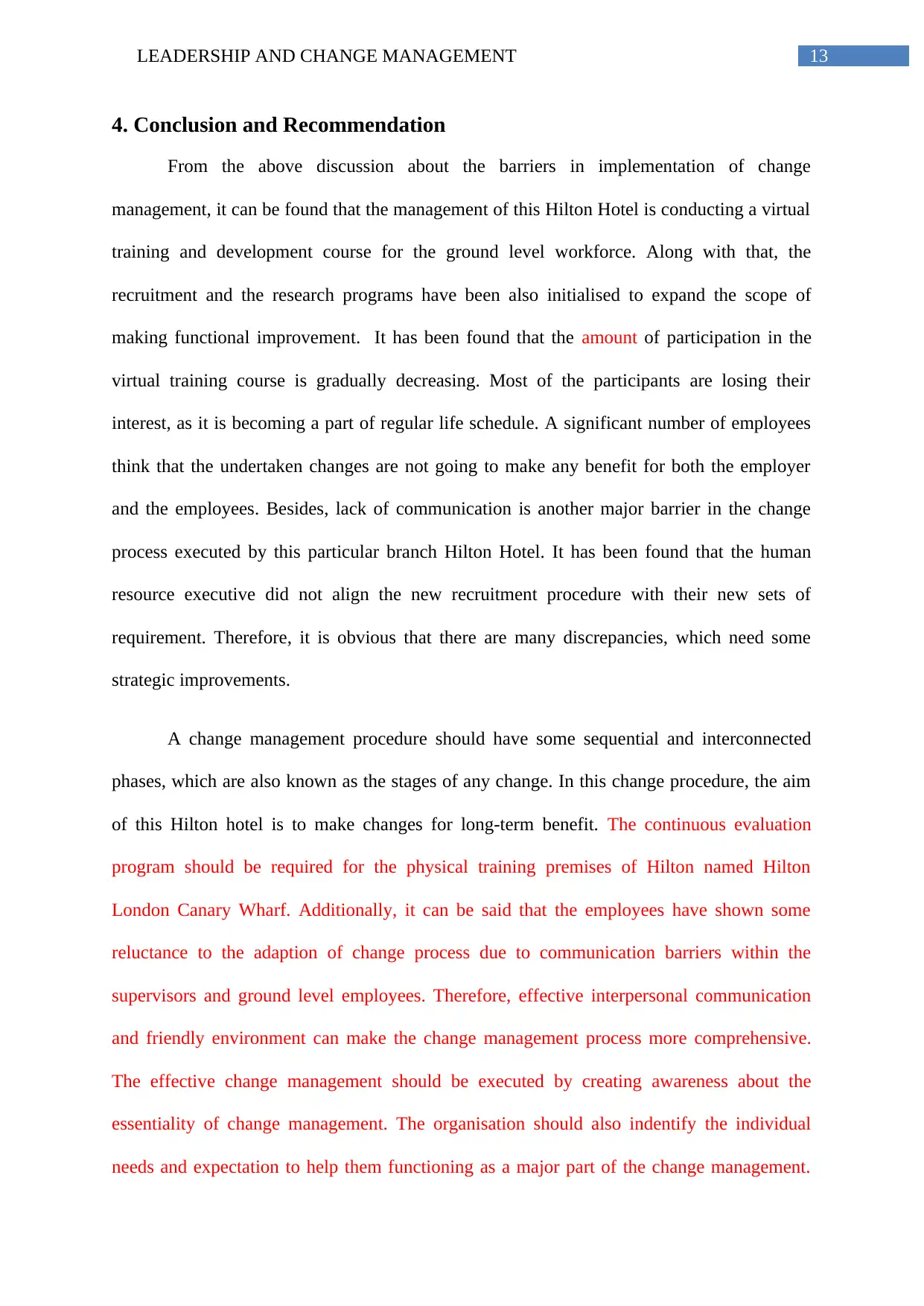
13LEADERSHIP AND CHANGE MANAGEMENT
4. Conclusion and Recommendation
From the above discussion about the barriers in implementation of change
management, it can be found that the management of this Hilton Hotel is conducting a virtual
training and development course for the ground level workforce. Along with that, the
recruitment and the research programs have been also initialised to expand the scope of
making functional improvement. It has been found that the amount of participation in the
virtual training course is gradually decreasing. Most of the participants are losing their
interest, as it is becoming a part of regular life schedule. A significant number of employees
think that the undertaken changes are not going to make any benefit for both the employer
and the employees. Besides, lack of communication is another major barrier in the change
process executed by this particular branch Hilton Hotel. It has been found that the human
resource executive did not align the new recruitment procedure with their new sets of
requirement. Therefore, it is obvious that there are many discrepancies, which need some
strategic improvements.
A change management procedure should have some sequential and interconnected
phases, which are also known as the stages of any change. In this change procedure, the aim
of this Hilton hotel is to make changes for long-term benefit. The continuous evaluation
program should be required for the physical training premises of Hilton named Hilton
London Canary Wharf. Additionally, it can be said that the employees have shown some
reluctance to the adaption of change process due to communication barriers within the
supervisors and ground level employees. Therefore, effective interpersonal communication
and friendly environment can make the change management process more comprehensive.
The effective change management should be executed by creating awareness about the
essentiality of change management. The organisation should also indentify the individual
needs and expectation to help them functioning as a major part of the change management.
4. Conclusion and Recommendation
From the above discussion about the barriers in implementation of change
management, it can be found that the management of this Hilton Hotel is conducting a virtual
training and development course for the ground level workforce. Along with that, the
recruitment and the research programs have been also initialised to expand the scope of
making functional improvement. It has been found that the amount of participation in the
virtual training course is gradually decreasing. Most of the participants are losing their
interest, as it is becoming a part of regular life schedule. A significant number of employees
think that the undertaken changes are not going to make any benefit for both the employer
and the employees. Besides, lack of communication is another major barrier in the change
process executed by this particular branch Hilton Hotel. It has been found that the human
resource executive did not align the new recruitment procedure with their new sets of
requirement. Therefore, it is obvious that there are many discrepancies, which need some
strategic improvements.
A change management procedure should have some sequential and interconnected
phases, which are also known as the stages of any change. In this change procedure, the aim
of this Hilton hotel is to make changes for long-term benefit. The continuous evaluation
program should be required for the physical training premises of Hilton named Hilton
London Canary Wharf. Additionally, it can be said that the employees have shown some
reluctance to the adaption of change process due to communication barriers within the
supervisors and ground level employees. Therefore, effective interpersonal communication
and friendly environment can make the change management process more comprehensive.
The effective change management should be executed by creating awareness about the
essentiality of change management. The organisation should also indentify the individual
needs and expectation to help them functioning as a major part of the change management.
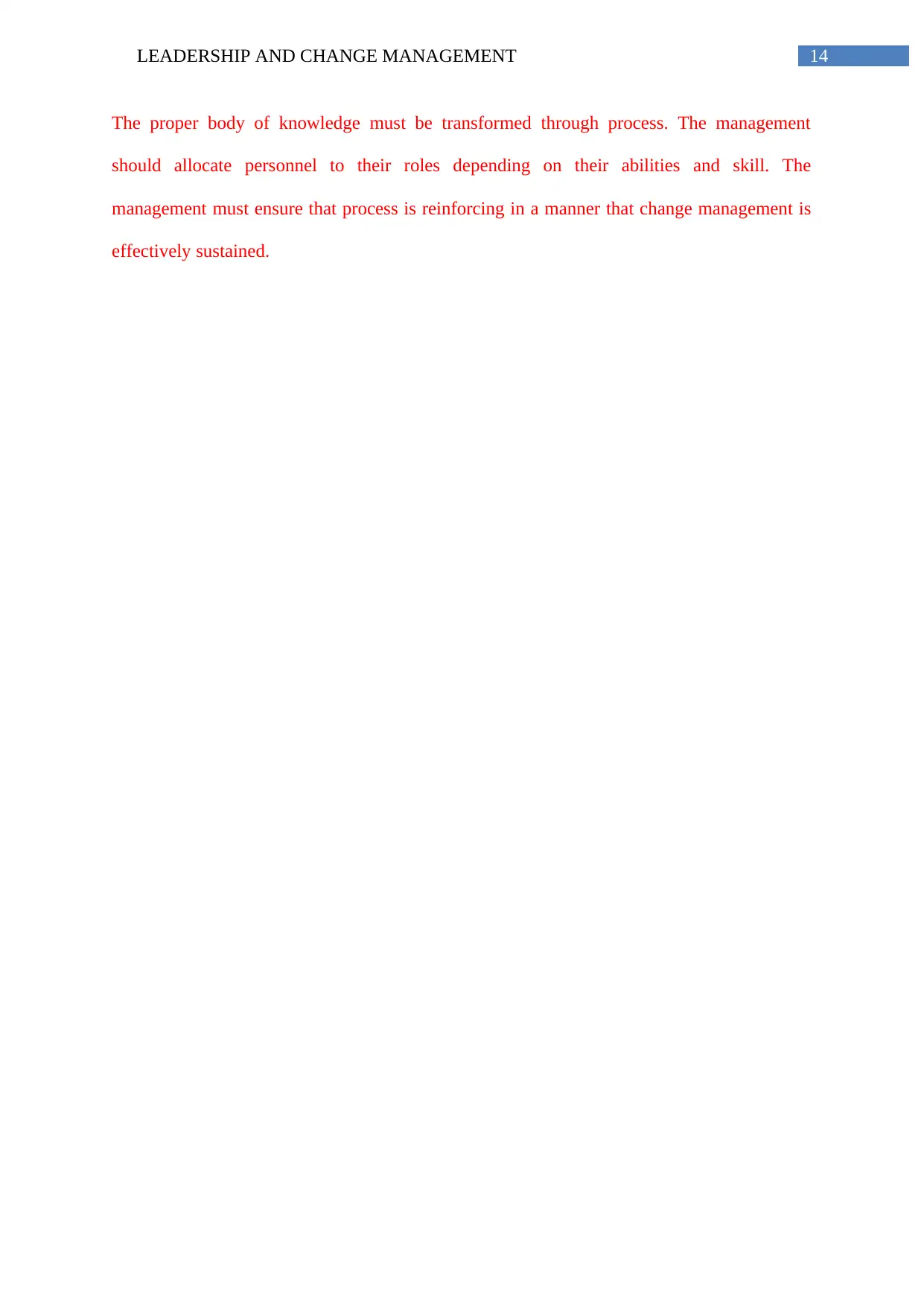
14LEADERSHIP AND CHANGE MANAGEMENT
The proper body of knowledge must be transformed through process. The management
should allocate personnel to their roles depending on their abilities and skill. The
management must ensure that process is reinforcing in a manner that change management is
effectively sustained.
The proper body of knowledge must be transformed through process. The management
should allocate personnel to their roles depending on their abilities and skill. The
management must ensure that process is reinforcing in a manner that change management is
effectively sustained.
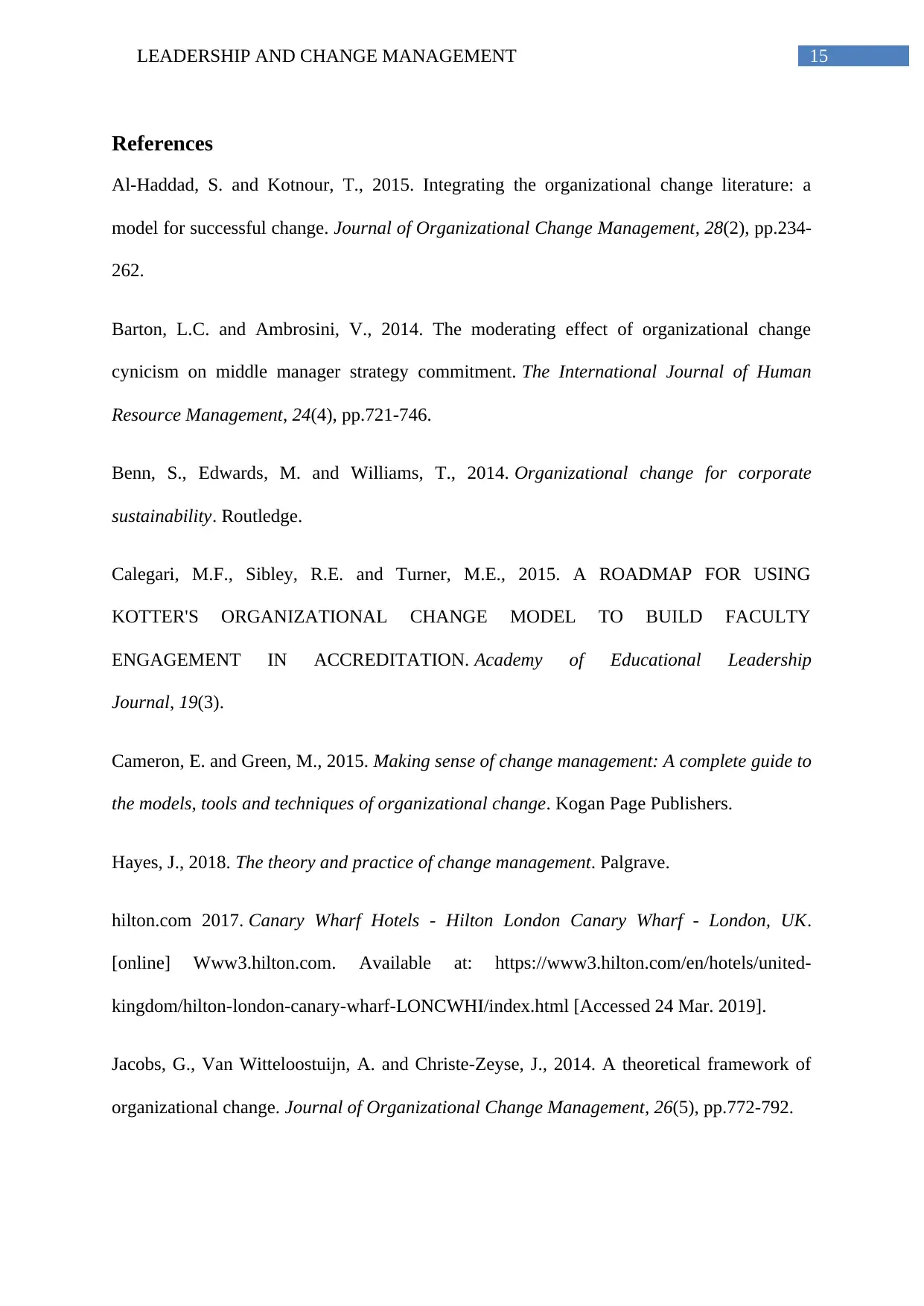
15LEADERSHIP AND CHANGE MANAGEMENT
References
Al-Haddad, S. and Kotnour, T., 2015. Integrating the organizational change literature: a
model for successful change. Journal of Organizational Change Management, 28(2), pp.234-
262.
Barton, L.C. and Ambrosini, V., 2014. The moderating effect of organizational change
cynicism on middle manager strategy commitment. The International Journal of Human
Resource Management, 24(4), pp.721-746.
Benn, S., Edwards, M. and Williams, T., 2014. Organizational change for corporate
sustainability. Routledge.
Calegari, M.F., Sibley, R.E. and Turner, M.E., 2015. A ROADMAP FOR USING
KOTTER'S ORGANIZATIONAL CHANGE MODEL TO BUILD FACULTY
ENGAGEMENT IN ACCREDITATION. Academy of Educational Leadership
Journal, 19(3).
Cameron, E. and Green, M., 2015. Making sense of change management: A complete guide to
the models, tools and techniques of organizational change. Kogan Page Publishers.
Hayes, J., 2018. The theory and practice of change management. Palgrave.
hilton.com 2017. Canary Wharf Hotels - Hilton London Canary Wharf - London, UK.
[online] Www3.hilton.com. Available at: https://www3.hilton.com/en/hotels/united-
kingdom/hilton-london-canary-wharf-LONCWHI/index.html [Accessed 24 Mar. 2019].
Jacobs, G., Van Witteloostuijn, A. and Christe-Zeyse, J., 2014. A theoretical framework of
organizational change. Journal of Organizational Change Management, 26(5), pp.772-792.
References
Al-Haddad, S. and Kotnour, T., 2015. Integrating the organizational change literature: a
model for successful change. Journal of Organizational Change Management, 28(2), pp.234-
262.
Barton, L.C. and Ambrosini, V., 2014. The moderating effect of organizational change
cynicism on middle manager strategy commitment. The International Journal of Human
Resource Management, 24(4), pp.721-746.
Benn, S., Edwards, M. and Williams, T., 2014. Organizational change for corporate
sustainability. Routledge.
Calegari, M.F., Sibley, R.E. and Turner, M.E., 2015. A ROADMAP FOR USING
KOTTER'S ORGANIZATIONAL CHANGE MODEL TO BUILD FACULTY
ENGAGEMENT IN ACCREDITATION. Academy of Educational Leadership
Journal, 19(3).
Cameron, E. and Green, M., 2015. Making sense of change management: A complete guide to
the models, tools and techniques of organizational change. Kogan Page Publishers.
Hayes, J., 2018. The theory and practice of change management. Palgrave.
hilton.com 2017. Canary Wharf Hotels - Hilton London Canary Wharf - London, UK.
[online] Www3.hilton.com. Available at: https://www3.hilton.com/en/hotels/united-
kingdom/hilton-london-canary-wharf-LONCWHI/index.html [Accessed 24 Mar. 2019].
Jacobs, G., Van Witteloostuijn, A. and Christe-Zeyse, J., 2014. A theoretical framework of
organizational change. Journal of Organizational Change Management, 26(5), pp.772-792.
Secure Best Marks with AI Grader
Need help grading? Try our AI Grader for instant feedback on your assignments.
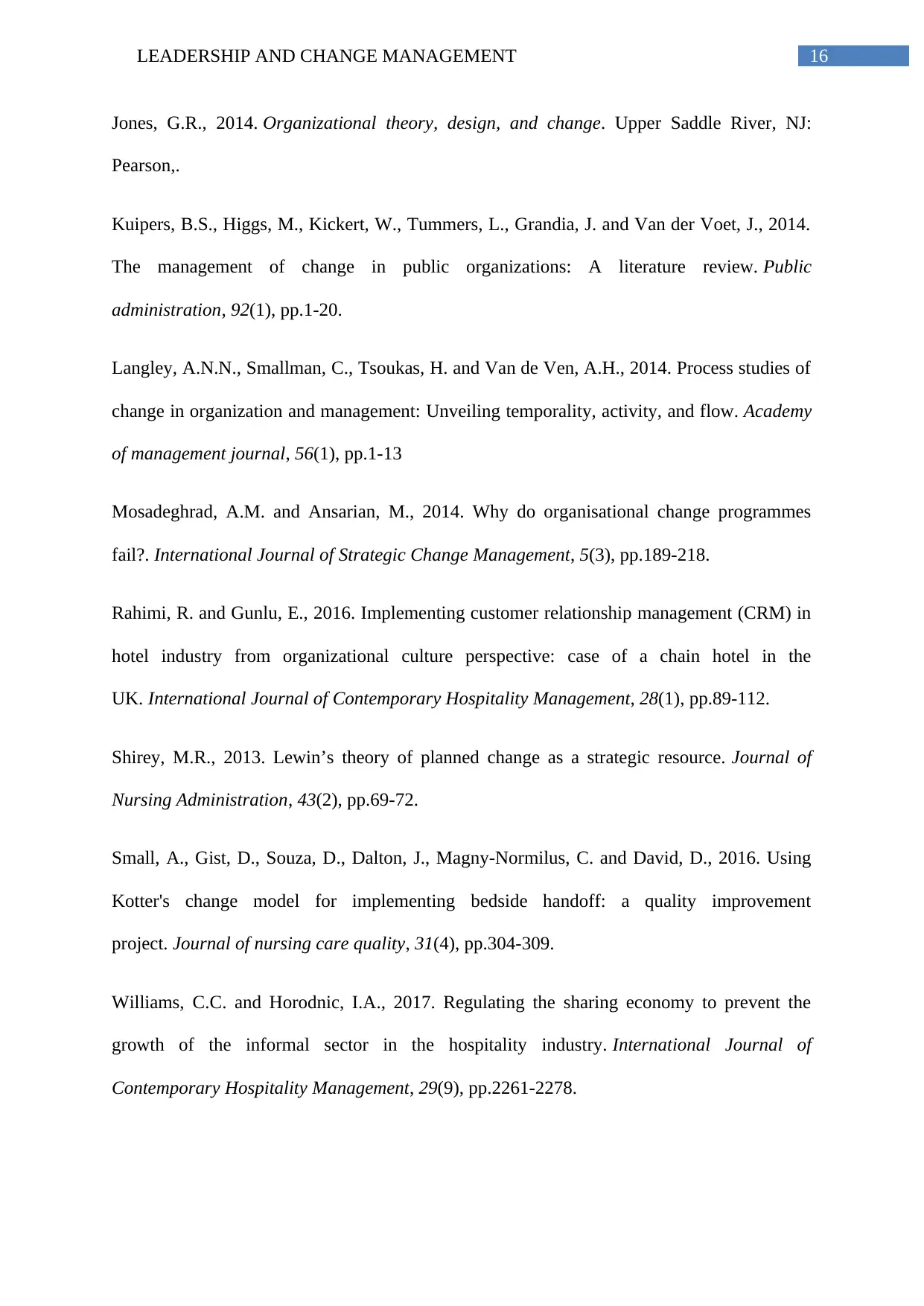
16LEADERSHIP AND CHANGE MANAGEMENT
Jones, G.R., 2014. Organizational theory, design, and change. Upper Saddle River, NJ:
Pearson,.
Kuipers, B.S., Higgs, M., Kickert, W., Tummers, L., Grandia, J. and Van der Voet, J., 2014.
The management of change in public organizations: A literature review. Public
administration, 92(1), pp.1-20.
Langley, A.N.N., Smallman, C., Tsoukas, H. and Van de Ven, A.H., 2014. Process studies of
change in organization and management: Unveiling temporality, activity, and flow. Academy
of management journal, 56(1), pp.1-13
Mosadeghrad, A.M. and Ansarian, M., 2014. Why do organisational change programmes
fail?. International Journal of Strategic Change Management, 5(3), pp.189-218.
Rahimi, R. and Gunlu, E., 2016. Implementing customer relationship management (CRM) in
hotel industry from organizational culture perspective: case of a chain hotel in the
UK. International Journal of Contemporary Hospitality Management, 28(1), pp.89-112.
Shirey, M.R., 2013. Lewin’s theory of planned change as a strategic resource. Journal of
Nursing Administration, 43(2), pp.69-72.
Small, A., Gist, D., Souza, D., Dalton, J., Magny-Normilus, C. and David, D., 2016. Using
Kotter's change model for implementing bedside handoff: a quality improvement
project. Journal of nursing care quality, 31(4), pp.304-309.
Williams, C.C. and Horodnic, I.A., 2017. Regulating the sharing economy to prevent the
growth of the informal sector in the hospitality industry. International Journal of
Contemporary Hospitality Management, 29(9), pp.2261-2278.
Jones, G.R., 2014. Organizational theory, design, and change. Upper Saddle River, NJ:
Pearson,.
Kuipers, B.S., Higgs, M., Kickert, W., Tummers, L., Grandia, J. and Van der Voet, J., 2014.
The management of change in public organizations: A literature review. Public
administration, 92(1), pp.1-20.
Langley, A.N.N., Smallman, C., Tsoukas, H. and Van de Ven, A.H., 2014. Process studies of
change in organization and management: Unveiling temporality, activity, and flow. Academy
of management journal, 56(1), pp.1-13
Mosadeghrad, A.M. and Ansarian, M., 2014. Why do organisational change programmes
fail?. International Journal of Strategic Change Management, 5(3), pp.189-218.
Rahimi, R. and Gunlu, E., 2016. Implementing customer relationship management (CRM) in
hotel industry from organizational culture perspective: case of a chain hotel in the
UK. International Journal of Contemporary Hospitality Management, 28(1), pp.89-112.
Shirey, M.R., 2013. Lewin’s theory of planned change as a strategic resource. Journal of
Nursing Administration, 43(2), pp.69-72.
Small, A., Gist, D., Souza, D., Dalton, J., Magny-Normilus, C. and David, D., 2016. Using
Kotter's change model for implementing bedside handoff: a quality improvement
project. Journal of nursing care quality, 31(4), pp.304-309.
Williams, C.C. and Horodnic, I.A., 2017. Regulating the sharing economy to prevent the
growth of the informal sector in the hospitality industry. International Journal of
Contemporary Hospitality Management, 29(9), pp.2261-2278.
1 out of 17
Your All-in-One AI-Powered Toolkit for Academic Success.
+13062052269
info@desklib.com
Available 24*7 on WhatsApp / Email
![[object Object]](/_next/static/media/star-bottom.7253800d.svg)
Unlock your academic potential
© 2024 | Zucol Services PVT LTD | All rights reserved.



